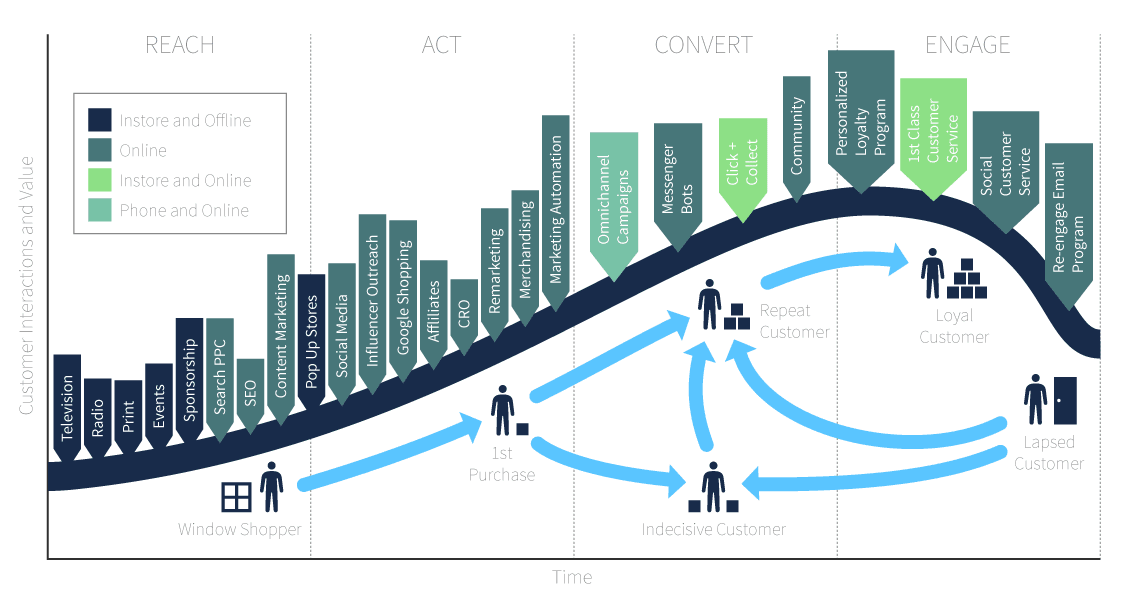Personalization offers great opportunities for retailers to improve relevance across the customer journey
Successful e-commerce marketing today requires consideration of the full customer path-to-purchase, shown below across the Smart Insights RACE planning framework.
The infographic shows the vast number of omnichannel touchpoints across paid, owned, and earned media, both online and offline. Although some visitors may convert in a single session, it is often far more complex. Research from Google gives the example of a customer called Stacy, searching for a new car which involved an incredible 900-plus digital interactions. Although a car is one of the most complex retail purchases, it makes the point of the need to recognize returning visitors and provide them context whichever device they are on.
Want more information on E-commerce personalization?
Download a FREE report, written in collaboration with PureClarity, “E-commerce personalization: The complete Buyer’s guide to selecting the best platform“. The report covers:
- Benefits of ecommerce personalization
- Essential personalization functionality
- Understanding and segmenting your audience
- Page types and placements
- Artificial intelligence and machine learning
- Best practices implementation
- Costing and pricing alternatives
- Full buyer’s guide checklist
Personalization benefits and essential functionality
Everyone has experienced personalization through retail product recommendations like those from Amazon, but you may not know there are many more personalization options available than the ‘people who viewed this, also purchased this’ recommendations you will be familiar with from Amazon.
Personalization benefits
Let’s introduce the benefits of personalization based on the 5S benefits of digital marketing identified by Dave Chaffey and PR Smith in their book Digital Marketing Excellence. These illustrate the factors that you should build into your business case. The rest may be obvious, but the others less so:
- Sell – The most obvious benefit of personalization is increasing your sales by recommending relevant products and offers through search and merchandising. The potential sales growth may be bigger than you think. We recommend you create a business case based on a spreadsheet model which shows the potential sales increase from new visitors and existing customers as conversion rates and average order values are improved across all page types and channels where you will deploy personalization.
- Speak – This refers to using digital media to initiate dialogue. In a retail context, this means encouraging site visitors to share their email addresses and permission to mail them. A common technique is to use a light-box or panel on a site offering a great deal on first purchase (for example, a 15% discount). Personalization services can deliver these messages and be used to tailor them for different types of visitor segment.
- Serve – Conversion can also be assisted by showing first-time purchasers that you are a trusted brand with a competitive service proposition (for example, by explaining discounts, shipping, and returns). These key brand messages are often delivered by retailers through a run-of-site feature like a site-wide stripe below the navigation, in a footer or a panel elsewhere on the home page. It’s useful to surface or add detail to the proposition on the home page. Different propositions or Unique Selling Points (USPs) may appeal to different customer segments so personalization enables you to tailor and target those key messages accordingly through your global merchandising zone.
- Save – If you select the right type of personalization system, the automated element can also reduce costs through time savings based on manual merchandising involving manually setting up product recommendations on home and category pages. Here we need to balance the requirement that all personalization solutions involve a degree of manual intervention. AI can reduce the manual effort since it collects and analyses big data and provides AI recommendations based on previous and current website behaviors, crowd trends and customer segment behavior. More sophisticated platforms further enable you to overlay with effective merchandising offers or marketing campaigns and adds an additional level of personalization into the mix. AI, especially, can help with the automation of merchandising which delivers the most relevant recommendation to the site visitor or email subscriber at the right time. This also relates to service improvements as personalization and conversion rate optimization can also potentially reduce returns by helping the customer select the right product.
- Sizzle – This is a softer benefit about adding more ‘pizzazz’ to your brand by adding a ‘wow’ factor for your site visitors. If you’re a lesser-known retail brand it can boost your credibility and visitor confidence through showing that you offer similar recommendation features and campaigns to the well-known retail brands. E-commerce personalization enables that ‘wow’ factor which helps to build brand loyalty and lifetime customer value.
View the full guide “E-commerce personalization: The complete Buyer’s guide to selecting the best platform” to review examples of personalization used in e-commerce and gain access to a personalization recommendations checklist.
